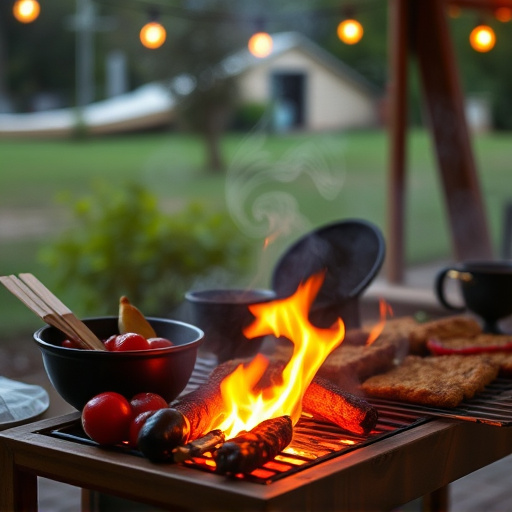To achieve exceptional BBQ baby back ribs, start with high-quality, marbled ribs and craft a balanced BBQ sauce using tomatoes, vinegar, sugar, spices, and brown sugar. Slow-roast at 275°F (135°C) for even cooking, then glaze with sauce during the final minutes for a sticky crust. Serve with side dishes like steamed corn, potato salad, and grilled veggies, and store leftovers properly for up to 4 days or freeze for up to 3 months.
Unleash the ultimate BBQ experience with a mouthwatering journey through the art of preparing perfect baby back ribs. This comprehensive guide takes you from selecting the tenderest cuts to crafting the savoriest barbecue sauce. Learn the science behind flavors, master slow-roasting techniques, and discover glazing secrets for fall-off-the-bone ribs. Explore side dish pairings and storage tips, ensuring every bite of your BBQ baby back rib recipe is a testament to culinary excellence.
- Choosing the Perfect Ribs: Tips for Selecting Tender Baby Back Ribs
- The Science Behind BBQ Sauces: Understanding Their Flavor Profiles
- Crafting the Ideal BBQ Sauce: Ingredients and Spices to Elevate Your Ribs
- Cooking Method: Mastering the Art of Slow-Roasting for Fall-Off-the-Bone Ribs
- Glazing Techniques: Adding a Sticky, Savory Finish to Your Ribs
- Pairings and Side Dishes: Completing Your BBQ Rib Experience
- Storing and Reheating Leftovers: Keeping Your Ribs Tasty Over Time
Choosing the Perfect Ribs: Tips for Selecting Tender Baby Back Ribs
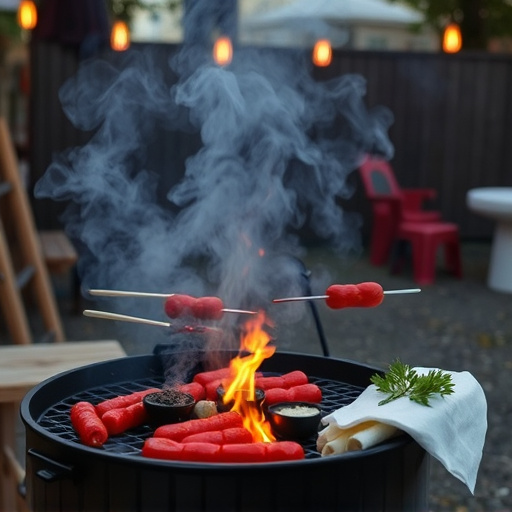
When it comes to crafting the perfect BBQ baby back ribs recipe, starting with high-quality ribs is essential. Look for ribs that are meaty, with a good amount of marbling (fat throughout the meat) and minimal visible sinew. Tenderness is key, so opt for ribs that feel firm yet give slightly when pressed, indicating they’re still juicy and not overcooked. A good rule of thumb is to choose ribs that have been aged or slow-cooked, as this process breaks down some of the collagen, making them incredibly tender when grilled.
Additionally, consider the cut: baby back ribs are typically cut from the top of the rib cage, offering a more compact and even cooking surface compared to larger cuts. This makes them ideal for barbecue as they cook evenly and quickly, locking in that mouthwatering flavor. Remember, the right pair of ribs is half the battle won when it comes to creating a savory BBQ sauce masterpiece.
The Science Behind BBQ Sauces: Understanding Their Flavor Profiles
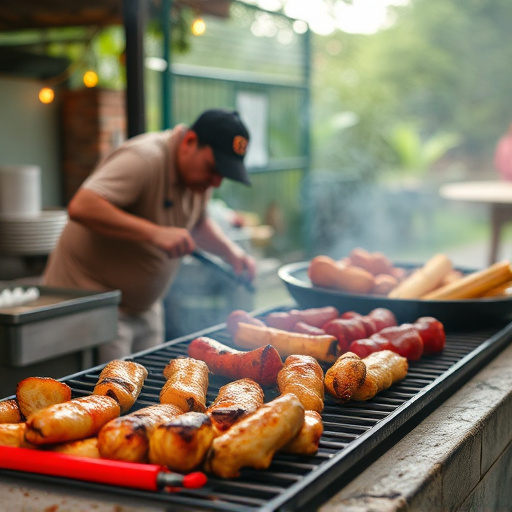
The Science Behind BBQ Sauces: Understanding Their Flavor Profiles
BBQ sauce, a staple in any barbecue lover’s pantry, is more than just a flavorful condiment—it’s a complex blend of ingredients that create a symphony of tastes. At its heart, a good BBQ sauce combines sweetness, acidity, and savory notes, often achieved through a combination of tomatoes, vinegar or lemon juice, sugar, salt, and various spices. The magic happens when these elements interact during cooking, enhancing the natural flavors of grilled meats like baby back ribs.
For a perfect BBQ baby back ribs recipe, understanding the science behind sauces allows for precise adjustments to suit personal tastes. Smoked paprika, garlic, and onion contribute earthy and pungent flavors, while chili powder adds a subtle heat that lingers delightfully on the palate. The key is balancing these elements—a delicate dance of sweet and spicy, tangy and savory—to create a sauce that not only complements but elevates the tender ribs, making each bite an unforgettable experience.
Crafting the Ideal BBQ Sauce: Ingredients and Spices to Elevate Your Ribs
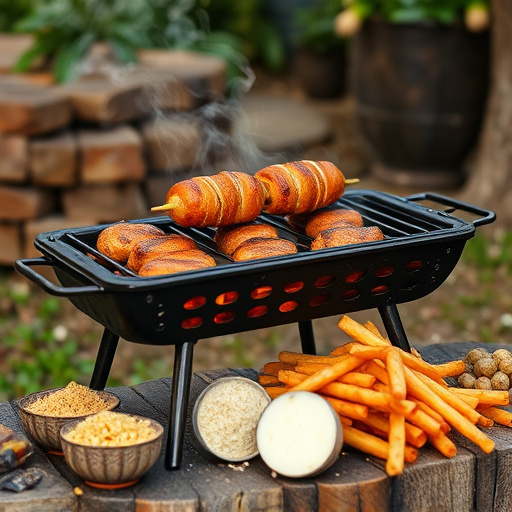
Crafting the perfect BBQ sauce for your bbq baby back ribs recipe involves balancing a variety of rich flavors and spices. Start with a base of tomato paste or pureed tomatoes, which provide depth and tanginess. Add a touch of brown sugar or molasses to bring out the sweetness, contrasting nicely with the savory notes from ingredients like garlic, onion powder, paprika, black pepper, and a pinch of cayenne for heat. Apple cider vinegar rounds out the sauce, offering acidity that cuts through the richness and helps tenderize the ribs.
Experimenting with different combinations of these ingredients allows you to tailor the sauce to your taste preferences. For instance, increasing the cayenne creates a spicier profile, while using less vinegar results in a thicker, richer sauce. The key is to simmer the mixture until all flavors meld together, creating a complex and delicious marinade for your tender baby back ribs.
Cooking Method: Mastering the Art of Slow-Roasting for Fall-Off-the-Bone Ribs
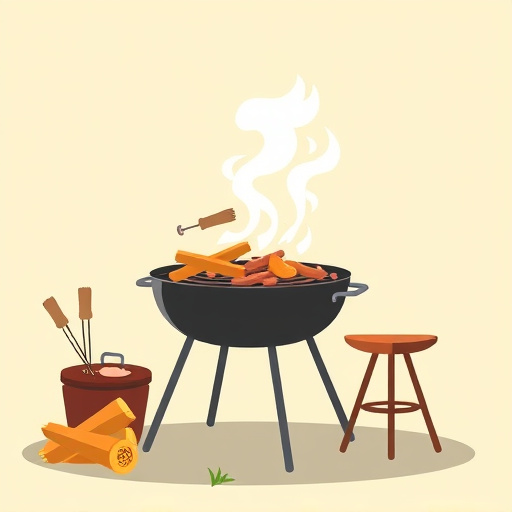
To achieve fall-off-the-bone baby back ribs, slow roasting is a technique that cannot be overstated in its importance. This method allows the ribs to cook evenly, ensuring the collagen in the meat breaks down slowly, resulting in tender, succulent slices. Preheat your oven to 275°F (135°C), a temperature sweet spot for slow-roasting ribs. Place the ribs on a rack in a roasting pan, bone side up, and bake undisturbed for 2-3 hours or until the meat starts to shrink away from the bone. The slow cooking process not only tenderizes the ribs but also helps to caramelize the sauce into the meat, enhancing every bite with rich, savory flavors.
During the slow roast, baste the ribs periodically with your favorite BBQ sauce. A good BBQ baby back ribs recipe often combines sweet and tangy notes, balanced with a touch of heat. This not only adds moisture but also helps to create a beautiful crust on the exterior while keeping the interior incredibly tender. The combination of oven time and saucing creates an unparalleled experience for rib lovers, making slow-roasted ribs a true masterpiece in BBQ cuisine.
Glazing Techniques: Adding a Sticky, Savory Finish to Your Ribs
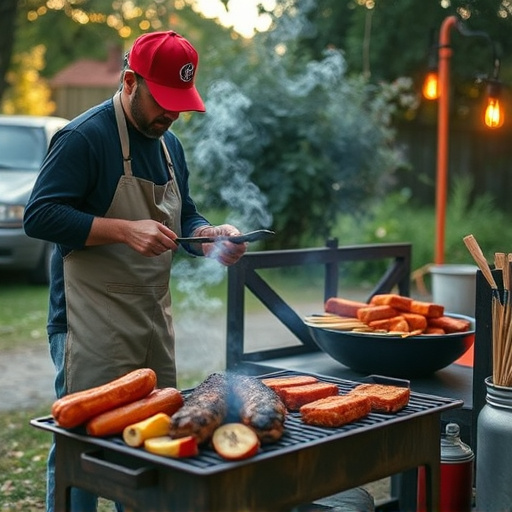
When it comes to glazing your BBQ baby back ribs, the technique is key to achieving that irresistible sticky and savory finish. The process involves applying a generous layer of sauce during the last few minutes of cooking, allowing it to caramelize and create a delicious crust. This step not only enhances the flavor but also seals in the meat’s juiciness. You can use a brush to evenly distribute the sauce, ensuring every inch of the ribs gets coated.
For an extra layer of complexity, consider baste your ribs with a mixture of sauce and melted butter during the last 10 minutes of cooking. This method adds richness and depth of flavor while keeping the glaze glossy and inviting. Remember, timing is crucial; you want to glaze just as your ribs reach the desired doneness for that perfect balance between tender meat and a delectable, slightly charred exterior.
Pairings and Side Dishes: Completing Your BBQ Rib Experience

When serving up your mouthwatering BBQ baby back ribs recipe, there are several side dishes and pairings that can elevate the overall dining experience. For a classic combination, opt for steamed or grilled corn on the cob, offering a simple yet delicious contrast to the rich, smoky sauce of your ribs. Potato salad is another popular choice, as its creamy texture and tangy dressing provide a refreshing balance to the hearty meat.
For a more robust pairing, consider grilled vegetables like zucchini, bell peppers, and onions. These add a burst of color and crunch, while also complementing the savory barbecue sauce. A simple coleslaw, dressed with a light vinegar-based sauce, can also cut through the richness of the ribs, making it an ideal side to round out your BBQ baby back ribs recipe.
Storing and Reheating Leftovers: Keeping Your Ribs Tasty Over Time
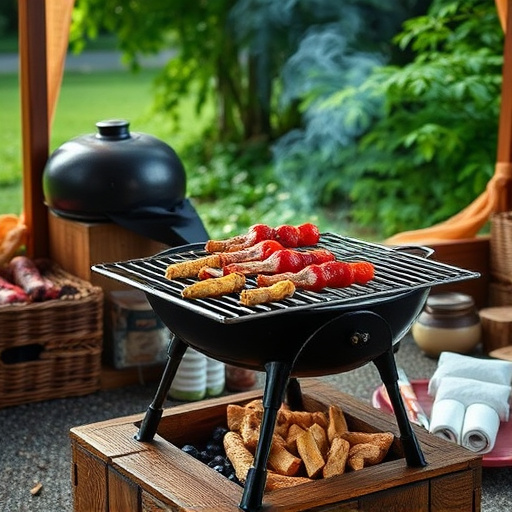
When you’ve indulged in a mouthwatering BBQ baby back ribs recipe, it’s common to have some leftovers. Proper storage is key to keeping them delicious and safe to eat. Place any leftover ribs in an airtight container or wrap them tightly in foil or plastic wrap before storing in the refrigerator. This can keep your ribs fresh for up to 3-4 days. If you’re planning to reheat, it’s best to do so gently in a low-temperature oven or on the stovetop to prevent drying out.
For longer-term storage, consider freezing your leftover ribs. Place them in freezer-safe containers or wrap them securely and freeze for up to 3 months. Thawing under cold water is ideal before reheating, ensuring your BBQ baby back ribs maintain their tender texture and juicy flavors.
